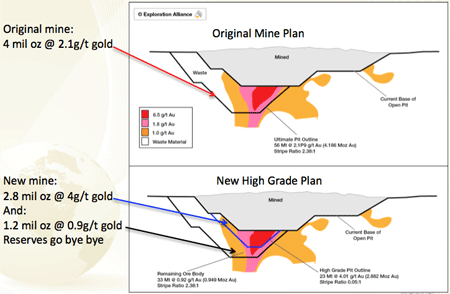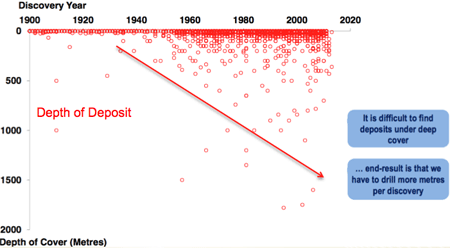Exploration Insights
Peak Discovery?
Brent Cook
Exploration Insights
Posted Feb 20, 2014
This past week, many of the larger gold mining companies came clean, announcing decreases in their gold reserves. Barrick acknowledged a 26% decline in reserves (down 36 mil oz from 140), over half of which is due to lowered
gold price assumptions ($1,100 vs. $1,500/oz). This bad news comes in addition to a $2.8 billion impairment charge, and after already pulling ~50 million ounces off the books from the Pascua Lama and Cerro Casale deposits which “did not meet investment criteria”. The change in its gold price assumption also resulted in a 2.5% increase in overall reserve grade for the company’s deposits, and a 16% increase at its active mining operations. Low grade mineralization was left out of the new estimates.
Goldcorp removed 11% of its reserves, after lowering its gold price assumption just $50/oz (from $1,350 to $1,300); if one includes the previously announced changes in its Penasquitos mine plan, a 19% decline overall. The decreased gold price assumption (plus resource-to-reserve conversions) resulted in a 29% (0.23g/t Au) increase in company-wide reserve grade. However, mined grade at most operations were above the reserve grade, suggesting the company is high grading its deposits.
Newcrest Mining stuck with its $1,250 gold price for reserves calculations, yet lopped 11% off its total reserves at year-end. Half-year profits were off 88% in 2013, but the company hopes to achieve positive free cash flow in 2014 via “optimizing current operations, maintaining growth options and maximizing free cash flow to enable the company to reduce gearing and return to paying dividends to shareholders," according to Managing Director Greg Robinson. Details were not provided.
Agnico Eagle reported a reserve decrease of ~9%, incorporating a gold price of $1,200, versus last year’s $1,392/oz. I have yet to compile the rest of the gold companies’ changes, and many are yet to announce, but I think you get the picture—reserves down almost across the board.
Kinross is a bit more interesting, and illustrates a point we have been making for some time now: We are mining more than is being found. The company reported a significant decrease in reserves, down 19.9 million ounces, of which 6.7 million is due to the loss of the FDN deposit in Ecuador. Excluding FDN, reserves declined by ~20%, using an unchanged $1,200 per ounce price deck. With the absence of new deposits and assuming the low grade, uneconomic, Lobo-Marte deposit stays that way, Kinross’s production profile looks rather dismal eight years out (Fig. 1 below).

(Fig. 1: Kinross production profile through 2020, assuming no Lobo-Marte or Tasiast ramp up. Source BMO)
Barring an increase in the gold price, the forward production profile of most of the large miners is similar to the preceding chart. Even an increasing gold price may not be relevant, however, if it is not accompanied by increasing profit margins. As you may recall from the distant past (2013), cost inflation by way of capex, labour, energy, consumables, and materials, plus excessive regulatory delays and additional corporate overhead, made the move in the gold price (from $500 to $1,500) almost immaterial to a company’s profitability. If that scenario-- an increasing gold price with concurrent cost inflation-- reoccurs, the gold deposits and reserves currently being downgraded are unlikely to reenter a company’s production profile.
The following chart (Fig. 2) graphically illustrates the real problem gold miners have faced as they tried to maintain or increase production. Since 1997, total tonnes mined went up by about 75%, while grade declined roughly 50%. In short, miners sacrificed grade in order to marginally increase total gold production (~1.7% annually) while barely improving earnings. Looking forward, it is clear that just to maintain current annual mine production of ~86 million ounces will require more of the same: higher throughput at perpetually lower grades—not a winning combination.

(Fig. 2: Tonnes mined vs. grade 1997 to 2020e. The increase in actual gold production over the time period was minor.)
The strategy of mining more tonnes at lower grades in the hopes of making money is the same futile exercise in “imagineered geo-fantasy” we just went through—it doesn't work. The fact is that the current game plan for gold miners is to increase profitability by way of various cost cuts, but mostly by selectively pulling the better ore out of the hole in the ground (high grading). Unfortunately, extrapolating that scenario to the chart above shows that increasing grade requires lowering the tonnes mined—usually in aging mines whose easily won ore is long gone. The net result of that course of action being the company is left with low grade uneconomic material (waste) and no way to turn that back into ore, without a real and sustained increase in the gold price—if then.
In a bit more detail, the graphic below (Fig. 3. Also see Exploration Insights Aug 11, 2013 for detailed review) illustrates what happens to an ore body when it has the guts pulled out of it (high graded). Material previously classified as ore becomes waste, and total mineable ounces decline. This decline in reserves is more than an accounting trick of moving the gold price deck around: Real rock has been extracted and left behind, and its grade is an inflexible fact.
(Click on image to enlarge)

(Fig. 3: Real life example of change in mineable reserves due to high grading a deposit. In this case, the original mine plan consisted of 4 mil oz @ 2.1g/t. But selectively mining 2.8 mil oz @ 4g/t in the new high grade plan leaves 1.2 mil oz @ 0.9g/t that are uneconomic. Effectively 30% of the resource is no longer economic, and will require significantly higher real gold prices to make money.)
Ultimately the gold miners’ only routes to increased profitability are: 1) A sustained real increase in precious metal prices without concurrent cost inflation; or, 2) Finding or acquiring new high margin deposits to replace production and reserve loss suffered due to high grading during lowered metal prices.
If the first case comes to pass, cancel this letter and buy the dozen or so companies with marginal dog deposits (we are working on a list). Detailed and fundamental analysis are little more than a distraction would be of very little value in stock picking. The game becomes playing the optionality of out-of-the-money ounces.
If, however, option two is the ultimate solution, the miners have a Real problem. Repeating, once again, our EI mantra: Legitimate economic discoveries are becoming harder and costlier to make, while the odds of success get even worse. The reasons are many, but let’s just look at one.
(Click on image to enlarge)

(Fig. 4: Depth of discoveries over time. Getting deeper)
The preceding figure dramatically illustrates the increasing depth of mineral discoveries over the past 100 years. The causes are quite simple: prospectors and geologists have covered the earth searching for near surface mineralization for centuries, beginning with a gold pan and ending with high definition satellite imagery. There are very few outcropping ore bodies left; therefore, we are forced to look under cover for blind ore bodies. Advances in geophysics, geochemistry, and geologic knowledge have improved our ability to see into the unknown--some. But testing any theory (story) becomes considerably more expensive these days due to increased depths and the geologic uncertainty resulting from the lack of surface rock exposure. In essence, we are now using drill holes to collect basic rock samples that we formerly were able to gather from the surface. Additionally, the cost of defining and mining deeper ore bodies often renders deposits that would have been economic if they were at the surface, uneconomic. The grade and tonne bar is, by default, much higher, and the number of remaining economic deposits fewer. Now throw in jurisdictional, social, environmental, regulatory, and political obstacles, and I think the problem becomes acute.
We are facing Peak Discovery--of the economic variety.
That’s the way I see it.
###
Feb 16, 2014
Brent Cook
website: www.explorationinsights.com
Brent Cook is an independent exploration analyst and advisor. He currently serves on the Advisory Board of several junior exploration companies and acts as a consultant to several institutional investors. Brent Cook produces the weekly investment newsletter Exploration Insights. For more information on Brent's letter please visit www.exporationinsights.com
Disclaimer - This letter/article is not intended to meet your specific individual investment needs and it is not tailored to your personal financial situation. Nothing contained herein constitutes, is intended, or deemed to be -- either implied or otherwise -- investment advice. This letter/article reflects the personal views and opinions of Brent Cook and that is all it purports to be. While the information herein is believed to be accurate and reliable it is not guaranteed or implied to be so. The information herein may not be complete or correct; it is provided in good faith but without any legal responsibility or obligation to provide future updates. Research that was commissioned and paid for by private, institutional clients are deemed to be outside the scope of the newsletter and certain companies that may be discussed in the newsletter could have been the subject of such private research projects done on behalf of private institutional clients. Neither Brent Cook, nor anyone else, accepts any responsibility, or assumes any liability, whatsoever, for any direct, indirect or consequential loss arising from the use of the information in this letter/article. The information contained herein is subject to change without notice, may become outdated and my not be updated. The opinions are both time and market sensitive. Brent Cook, entities that he controls, family, friends, employees, associates, and others may have positions in securities mentioned, or discussed, in this letter/article. While every attempt is made to avoid conflicts of interest, such conflicts do arise from time to time. Whenever a conflict of interest arises, every attempt is made to resolve such conflict in the best possible interest of all parties, but you should not assume that your interest would be placed ahead of anyone else's interest in the event of a conflict of interest. No part of this letter/article may be reproduced, copied, emailed, faxed, or distributed (in any form) without the express written permission of Brent Cook. Everything contained herein is subject to international copyright protection.
321gold Ltd

|